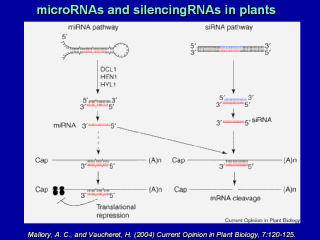| front |1 |2 |3 |4 |5 |6 |7 |8 |9 |10 |11 |12 |13 |14 |15 |16 |17 |18 |19 |20 |21 |22 |23 |24 |25 |26 |27 |28 |29 |30 |31 |32 |33 |review |
 |
Finally, do epigenetic mechnisms of the kind
Iíve discussed play any role in normal plant development? Well, the evidence is beginning to accumulate in bits and pieces that they do. First of all, several DNA methylase genes have been identified and cloned in Jean Finneganís lab over the past few years. Methylase antisense plants have been made and have substantially reduced DNA methylation levels. Although such plants are viable, they tend to have many developmental anomalies that become progressively more acute with each generation. Similarly, the ddm1 mutation identified by Eric Richards, which affects a putative chromatin protein, results in the general hypomethylation of DNA and a similar range of developmental anomalies that worsen as the homozygote is propagated. I draw your attention to this interesting parallel: methylation antisense plants and ddm1 mutant plants mirrors what has been observed with transposon inactivation and reactivation, paramutation and PAI gene methylation. In all of these different cases, changes in methylation are slow, progressing over several plant generations. Recovery from hypomethylation is also slow: methylation levels recover slowly when the methylase transgene or the ddm mutation are segregated away. But these are gross effects, difficult to dissect. Evidence is accumulating that methylation is involved in the transition to the reproductive phase of development. Flowering is controlled by a number of different signals, including day length, temperature, light and hormone levels. Finnegan and her co-workers have reported that vernalization, the requirement for a period of cold temperatures for the initiation of flowering, involves DNA methylation. |